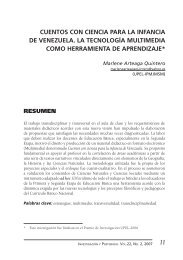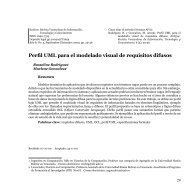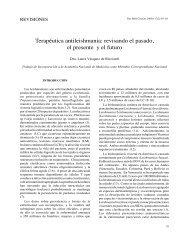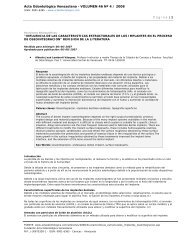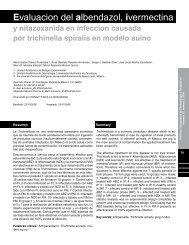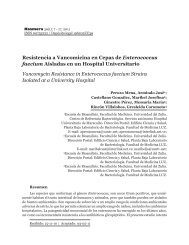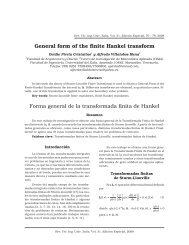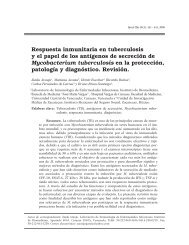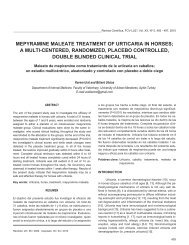BIOMETRY AND LIFE CYCLE OF Chironomus ... - SciELO
BIOMETRY AND LIFE CYCLE OF Chironomus ... - SciELO
BIOMETRY AND LIFE CYCLE OF Chironomus ... - SciELO
Create successful ePaper yourself
Turn your PDF publications into a flip-book with our unique Google optimized e-Paper software.
BIOMETRÍA E CICLO DE VIDA DE <strong>Chironomus</strong> calligraphus Goeldi, 1905 (DIPTERA, CHIRONOMIDAE) EM<br />
CONDIÇÕES DE LABORATÓRIO<br />
Florencia L. Zilli, Luciana Montalto, Analía C. Paggi e Mercedes R. Marchese<br />
RESUMO<br />
As larvas de quironomídeos são componentes importantes da<br />
biota aquática por sua participação nas tramas tróficas e por<br />
serem bioindicadores de condições ambientais. Muitos estudos<br />
de laboratório têm analisado os efeitos de diferentes contaminantes<br />
sobre quironomídeos, especialmente sobre <strong>Chironomus</strong><br />
calligraphus Goeldi, 1905. No entanto, pouco se conhece sobre<br />
os atributos de seu ciclo de vida. O objetivo deste estudo foi<br />
analisar o ciclo de vida de C. calligraphus em condições de<br />
laboratório. A razão de crescimento entre estágios larvais foi<br />
aproximadamente constante (r= 1,60 ±0,02), o tempo de desenvolvimento<br />
(D) foi de 15 dias e o tempo mínimo de geração (G)<br />
foi de 18 dias. De acordo a estes resultados e a observações realizadas<br />
em campo, C. calligraphus é uma espécie com ciclo de<br />
vida temperatura-dependente com gerações superpostas de curta<br />
duração em primavera-verão e com uma ou duas gerações de<br />
maior duração no inverno.<br />
a predominantly Neotropical<br />
distribution. This<br />
species was reported to<br />
have a high potential as<br />
a nuisance to humans in<br />
the USA, mainly because<br />
it has the ability to thrive<br />
in a wide range of conditions<br />
and habitats, including<br />
small and temporary<br />
waters (Spies, 2000;<br />
Spies et al., 2002). There<br />
are reports about its morphology<br />
(Goeldi, 1905; Roback,<br />
1962; Fittkau, 1965; Paggi,<br />
1979; Spies et al., 2002), karyology<br />
and DNA sequencing<br />
(Spies et al., 2002) as well as<br />
many ecotoxicology test studies<br />
(Iannacone and Alvariño,<br />
1998; Iannacone and Dale,<br />
1999; Iannacone et al., 1999),<br />
but there is no available information<br />
about the life cycle of<br />
this species. The present study<br />
provides information about the<br />
life cycle of C. calligraphus<br />
under laboratory conditions.<br />
Methods and Material<br />
Sampling<br />
Egg masses of <strong>Chironomus</strong><br />
calligraphus Goeldi, 1905<br />
were collected in field waters<br />
of Santo Tomé city (Santa<br />
Fe, Argentina, 31°40’2.54”S<br />
and 60°45’13.09”W) in January<br />
2007 and transported to<br />
the laboratory, conditioned in<br />
recipients with environmental<br />
water at 21.8 ±3.2ºC.<br />
Laboratory rearing<br />
The egg masses were placed<br />
in Petri dishes and left up to<br />
Figure 1. <strong>Chironomus</strong> calligraphus at larval instar IV. a: head capsule, ventral view, b: larva, lateral view.<br />
the moment when the first<br />
instar left the mucilaginous<br />
mass that served for its nutrition.<br />
The number of eggs per<br />
mass, and the width (µm) and<br />
length (µm) of each egg were<br />
measured under an optic microscope.<br />
After that period, the<br />
larvae were separated and<br />
cultured individually in 10<br />
plastic aquaria (12×21×6cm)<br />
with permanently oxygenated<br />
water (1 lit) at room<br />
temperature. The larvae were<br />
fed with a finely ground suspension<br />
of flaked fish food<br />
(TetraMin ® , Germany) every<br />
two days. Larvae were<br />
collected daily from each<br />
aquarium and the aquaria<br />
were kept covered to retain<br />
the adults at emergence. The<br />
air temperature of 22.5-31ºC<br />
held throughout the duration<br />
of the study.<br />
Life cycle and larval instars<br />
The collected larvae (Figure<br />
1) were fixed and conserved in<br />
70% alcohol. The larvae head<br />
capsule width (maximum ventral<br />
width of the cephalic capsule<br />
measured transversely to<br />
the major body axis) and the<br />
total body length (from the<br />
anterior margin of the cephalic<br />
capsule to the final portion<br />
of the last abdominal segment)<br />
were measured (µm) using an<br />
optic microscope with a micrometric<br />
scale. A population<br />
growth curve showing the relationship<br />
between total body<br />
length (µm) and time (days)<br />
was obtained. The larvae were<br />
separated into instars according<br />
to the relationship between<br />
head capsule width and total<br />
body length. In order to determine<br />
the growth rate between<br />
instars, the Dyar proportion<br />
(r; Dyar, 1890) was calculated<br />
considering its widespread application<br />
in arthropods (Strixino,<br />
1973).<br />
The time up to eclosion, the<br />
mean duration of each instar,<br />
the immature development<br />
time D (average time from<br />
egg deposition to adult emergence,<br />
when females were<br />
available; Danks, 2006), the<br />
minimum generation time G<br />
(mean interval from oviposition<br />
to the first progeny of the<br />
next generation; Danks, 2006)<br />
and the mean generation time<br />
(G) of the population by determining<br />
the lasting time of<br />
emergence, were recorded.<br />
The studied material was deposited<br />
at the Instituto de Limnología<br />
Dr. Raúl A. Ringuelet,<br />
La Plata, Argentina.<br />
Results and Discussion<br />
The eggs measured 317.7<br />
±20.0µm in length and 119.1<br />
±10.3µm in width. The range<br />
of variation in the number<br />
of eggs per mass (369-374)<br />
was lower than that registered<br />
for tropical C. xanthus (500-<br />
1045) by Trivinho-Strixino<br />
and Strixino (1982). In this<br />
sense, subtropical C. calligraphus<br />
could have improved its<br />
fitness by increasing the size<br />
of each egg rather than the<br />
number. The hatching period<br />
was of approximately 3 days.<br />
The larval instars were<br />
clearly separated when measuring<br />
the head capsule width<br />
to total body length relation<br />
(Figure 2). The data collected<br />
about mean head capsule<br />
width, total body length,<br />
growth rate and duration of<br />
the different larval instars of<br />
C. calligraphus is summarized<br />
in Table I. In the second<br />
instar the larvae showed a<br />
bottom exploratory behavior<br />
and constructed the tubes.<br />
They also started to develop<br />
the tubules of the eight segments.<br />
768 OCT 2008, VOL. 33 Nº 10




